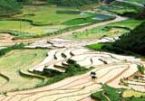Sapa, Lao Cai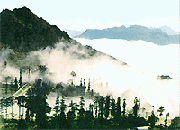
Visitor to Sapa in summer can feel the climate of four seasons in one day. In the morning and afternoon, it is cool like the weather of spring and autumn. At noon, it is as sunny and cloudless as the weather of summer. And it is cold in the evening. With no advance warning of a thunderstorm short and heavy rains may come at noon on any summer day. Subsequently, a rainbow appears, transforming Sapa into a magic land, which for years has been a constant source of poetic inspiration, lights up the whole region.
The best time to witness the scenic beauty of Sapa is in April and May. Before that period, the weather might be cold and foggy; after that period is the rainy season. In April and May, Sapa is blooming with flowers and green pastures. The clouds that settle in the valley in early morning quickly disappear into thin air.
Sapa has many natural sites such as Ham Rong Mountain, Silver Waterfall, Rattan Bridge, Bamboo Forest and Ta Phin Cave. Sapa is also the starting point for many climbers and scientists who want to reach the top of Fansipan Mountain, the highest mountain in Vietnam at 3,143m. Hoang Lien Mountain Range is also called the Alps of the North Sea area since Fansipan Mountain is not only the highest peak in Vietnam, but also in the Indochina Peninsula. The pyramid-shaped mountain is covered with clouds all year round and temperatures often drop below zero, especially at high elevations.
The first thing you notice when approaching the resort town are some detached wooden mansions and villas perched on a hill top or hillside, behind thick pine forests and almost invisible on this foggy morning. Old and new villas with red roofs now appear and now disappear in the green rows of pomu trees, bringing the town the beauty of European towns.
Fresh and cool air in Sapa is an idea climate condition for growing temperate vegetables such as cabbage, chayote, precious medicinal herbs, and fruit trees such as plum, pear…
Sapa is home to various families of flowers of captivating colours, which can be found nowhere else in the country. When Tet, the Lunar New Year Festival, comes, the whole township of Sapa is filled with the pink colour of peach blossom brought from the vast forests of peach just outside the town. Sapa is regarded as the kingdom of orchids. Here, orchid lovers are even amazed by the choice, when trekking in the forest filled with several hundred kinds of orchids of brilliant colours and fantastic shapes, such as Orchid Princess, Orchid of My Fair Lady's Shoe. Some orchids are named after lovely singing birds such as the canary, salangane's nest, and more
Sapa is most beautiful in spring. Apricot, plum and cherry flowers are splendidly beautiful. Markets are crowded and merry, and are especially attractive to visitors. Minority groups come here to exchange and trade goods and products. Market sessions are also a chance for locals to promenade and young men and women in colorful costumes to meet, date or seek sweethearts.
Visitors to Sapa will have opportunities to discover the unique customs of the local residents.
Love market - a place for a date, Sapa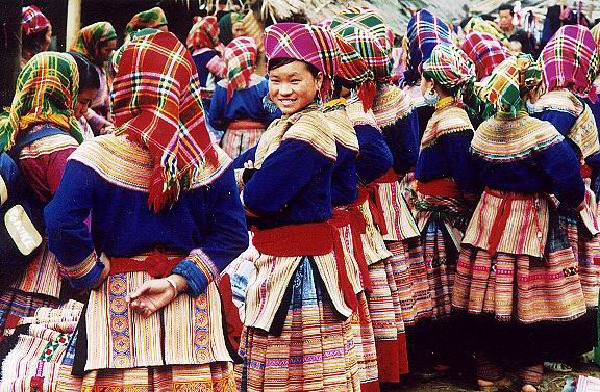
Every Saturday, the picturesque mountain village of Sa Pa comes alive with shoppers who know what they want: love. They travel from near and far to size up the goods of the day, hoping something will tickle their fancy.
Tall or short, sweet or sultry, they are all on the market, looking for love. Love markets (cho tinh) take place in the northern mountain provinces of Lao Cai, Ha Giang and Son La. A rare opportunity to mix, mingle and find a match, they are often a not-to-be-missed social event. For many young villagers, the love fests are a vital marital resource, given that many live in villages where all the inhabitants are blood relatives.
Here’s how it goes: singles strut their stuff through the market, hoping they will be lucky enough to be asked out on a date. What follows is not as simple as dinner and a movie – amorous couples must abide by the ways and mores of their ethnic nationality.
Unlike the steady flow of sensuality at Sa Pa, some loves must stand the test of time. Khai Vau market in Ha Giang province takes place only once a year, on March 27 in the lunar calendar, a date known as Phong Luu 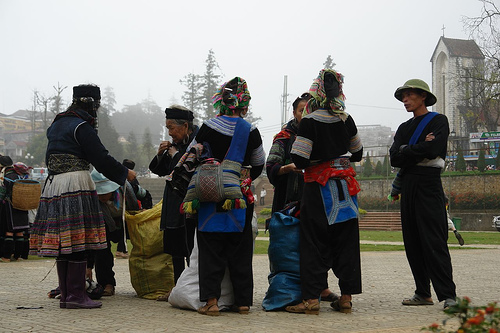 (Prosperity Day), which gives the market its name of Cho Phong Luu (market of Prosperity). According to legend, the market’s beginnings date back to the unrequited love between a young boy and girl. They met in Meo Vac, but as they were from different tribes, were forbidden to be together. (Prosperity Day), which gives the market its name of Cho Phong Luu (market of Prosperity). According to legend, the market’s beginnings date back to the unrequited love between a young boy and girl. They met in Meo Vac, but as they were from different tribes, were forbidden to be together.
In true Shakespearean fashion, a bitter quarrel erupted between the families, and the couple was forced to end the affair. Unable to bear the thought of never seeing each other again, they decided to meet on the same day every year in Khau Vai. Today, the site of the forbidden rendezvous is home to the love market.
The market is not just for marriage hopefuls. In this rural area, it is also the social event of the year, where old friends meet up and new ones are made. No matter their age, everyone looks forward to the chance to chat over sticky rice, grilled cassava or rice dumplings. Although the market does not officially start until March 27, the celebrations begin the evening before. March 26 is a night of song and dance, the performances expressing fervent wishes for eternal love. Romantic melodies fill the night air.
There is one day in the year
I dedicate to you
I have no gold or silver
Just my true love
Come with me if you believe in me
The dancing and singing continue into the early hours, often persuading men and women into each other’s arms. That first magical night, some are lucky enough to leave the market with their new partners and walk hand in hand through the forest. But others are simply nervous: tomorrow is the big day, after all. Many have waited months for the chance to find their soul mate. The day of the Market of Prosperity is alive with different moods: happiness at meeting old friends, anxiety as others wait to meet someone new.
Whether they find a partner or not, the happy memories of the day linger in the minds of many of these mountain people. And anyway, there is always next year. Because at this market, the goods are always ripe.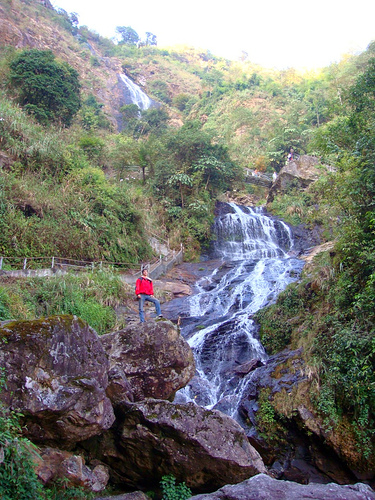
Silver Falls, Thac Bac, Sapa
Eight miles (13km) from Sapa is the Thac Bac Water fall (the one in the picture). You can get here easily on a motorbike.
This is one of the region's major attractions. It is possible to climb to the top of the waterfalls. From there, there is an excellent view of the waterfalls. If you come here, follow the road and you will get to the Tram Ton pass.
Ham Rong Mountain, Lao Cai
Legend has it that in the distance past, all animals lived together in a chaotic environment. One day, Jade Emperor gave an order that every species of animal had to find for them an area to live. Having heard the order, they scrambled for a place to reside. The three brothers of dragon who were living in a large lake hurriedly ran to the east but could not find any place; they then ran to the west. The two older brothers ran fast and came to the destination first. The youngest brother ran slowly and strayed into the crowds of lions, tigers and big cats. Fearing that these animals would attack it, the dragon opened its mouth to defense itself. At that time, the order of Jade Emperor was no longer available, so the three dragons petrified. The two older dragons, which were waiting for their brother, face Lao Cai Town, and the youngest one raising its head and opening mouth faces the Hoang Lien Mountain Range. So the mountain is named Ham Rong (Jaw of Dragon).
Visitors to Ham Rong have chances to climb up the San May (Cloud Yard) to enjoy the panorama of Sapa Townlet, visit the orchid gardens with beautiful and colorful flowers. In addition, Ham Rong Mountain has numerous caves and stones in extraordinary shapes.
Fansipan Mountain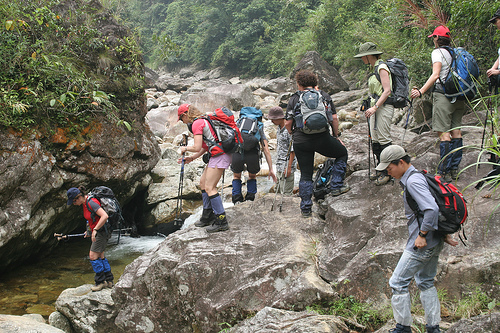
Geologists say the Hoang Lien Mountain Range, with Fansipan as its highest peak, did not emerge in the mountainous North West of Vietnam until the neozoic period (circ. 100 million years ago). Fansipan, a rough pronunciation of the local name “Hua Xi Pan†means “the tottery giant rockâ€. The French came to Vietnam and in 1905 planted a landmark telling Fansipan’s height of 3,143m and branded it “the Roof of Indochinaâ€. Very few people climbed to the top of Fansipan at the time. Then came the long years of war and Fansipan was left deserted for hunting and savaging. The trail blazed by the French was quickly overgrown by the underbrush.
It takes six or seven days to reach the 3,143m summit, the highest peak of the Indochina Peninsula.
In 1991, Nguyen Thien Hung, an army man returned to the district town and decided to conquer Fansipan. Only on the 13th attempt did Hung, with a H’Mong boy as his guide, conquer the high peak by following the foot steps of the mountain goats. Scaling the height was meant to satisfy his eager will and aspiration to conquer the mountain without expecting that his name would be put down in the travel guidebook. After that the Sapa Tourism Agency started a new package tour there. It seemed the Fansipan Tour was meant only for those who wished to test their muscular power.
The summit of Fansipan is accessible all year round, but the best time to make the ascent is from mid-October to mid-November, and again in March.
Foreigners like best to book Fansipan tours between October and December, as this period is more often than not free from the heavy rains that obstruct the jaunt. But the Vietnamese prefer their tours to the peak of the mountain from February to April, as it is not so cold then. However, the best time for the trek to the mountain is from the end of February to the start of March, when the flowers all flourish and the climbers may behold the carpets of brilliant blossoms, violets and orchids, rhododendrons and aglaias.
|


 (Prosperity Day), which gives the market its name of Cho Phong Luu (market of Prosperity). According to legend, the market’s beginnings date back to the unrequited love between a young boy and girl. They met in Meo Vac, but as they were from different tribes, were forbidden to be together.
(Prosperity Day), which gives the market its name of Cho Phong Luu (market of Prosperity). According to legend, the market’s beginnings date back to the unrequited love between a young boy and girl. They met in Meo Vac, but as they were from different tribes, were forbidden to be together.

